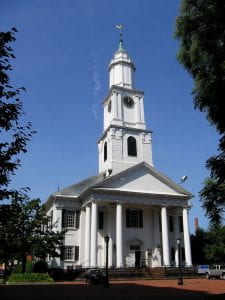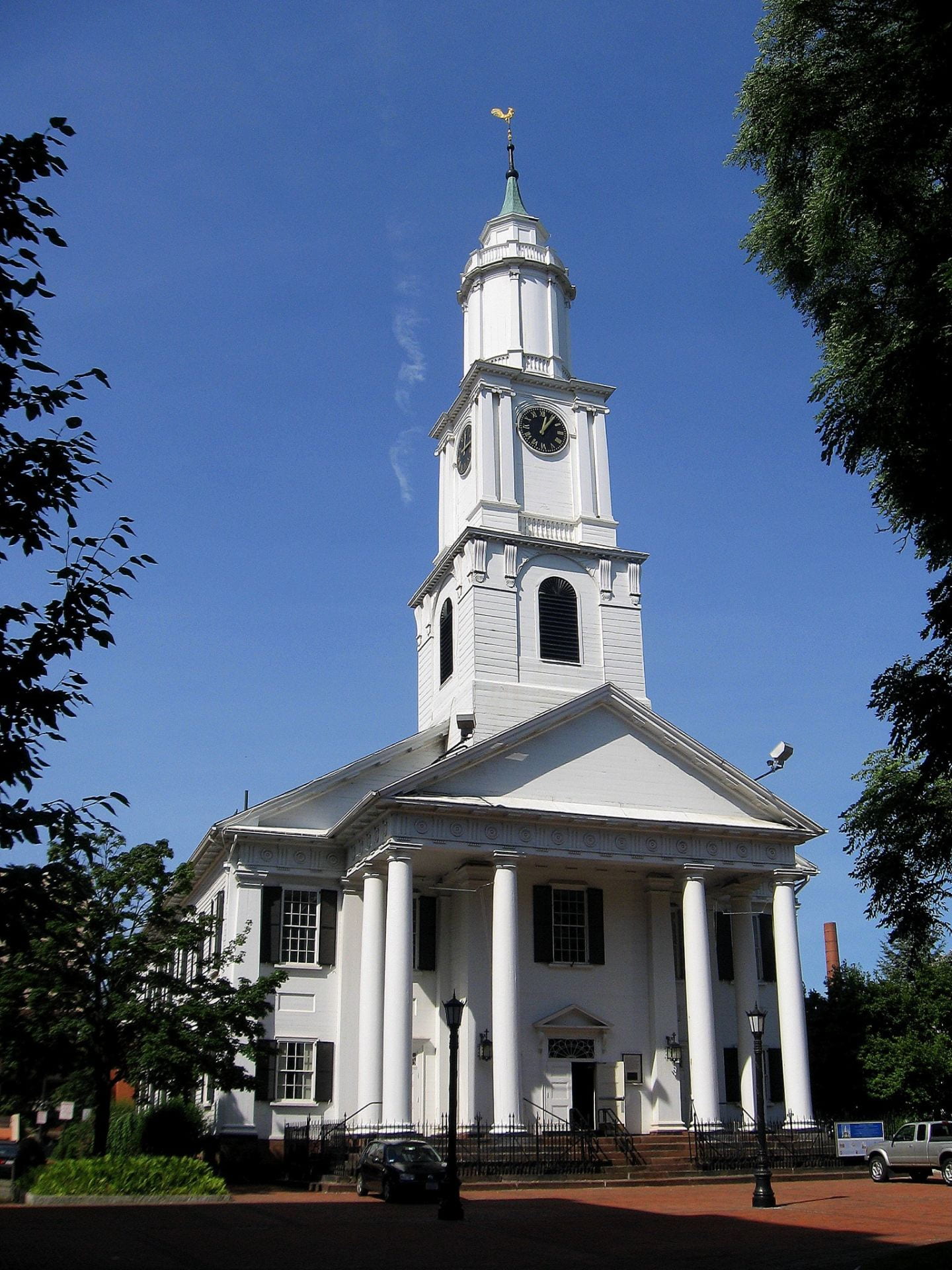History is complicated. Over the past two months, as I have been traveling across New England and the South, I kept hearing this phrase. Lincoln was not an anti-racist. The founding fathers were enslavers. Israel Trask was not solely bad.
If you have read my previous posts in this series, you might be surprised to see that; after all, Trask was a pretty bad person by modern standards. But was also involved in various philanthropic efforts and had a complicated relationship with emancipation and abolition, as one might expect when one is an enslaver and lives in a free state like Massachusetts. This post thus seeks to delineate, if not explain, some of Trask’s role in an increasingly abolitionist world.

The first complication presents itself in Trask’s religious life. After moving to Springfield in spring 1821, Israel E. and wife Elizabeth (née Carter) Trask were admitted to the First Congregational Church, the oldest congregation in the city then under the direction of the Rev. Samuel Osgood. At the time of his death in 1835, Trask had endowed pews 9 and 23 for a total of $363, but he doubtless contributed more to the church. Correspondence in the Israel Trask Papers suggests that the Trask and Osgood families were friendly, if not friends. A February 17, 1829, letter from Israel instructs Elizabeth to “[g]ive my thanks to Mr. Osgood, if you should see him, for his friendly calls” (Box 1, Folder 13). A later letter dated February 23, 1832, reads:
I am very grateful to Mr. Osgood for his kind attentions to wife & children. Excuse the inquiry–Is Mrs. Osgood in good health? I hope she is not failing. You may inform him that I was never in better health. (Box 1, Folder 15)
These types of interactions are in no way unusual for a reverend and congregant. When the congregant is an enslaver and the reverend an abolitionist, though, things become slightly murkier. Indeed, Rev. Samuel Osgood was a prominent abolitionist as a member of the Hampden County Anti-Slavery Society and a conductor on the Underground Railroad. If Osgood ever counseled Trask on his activities as an enslaver, it is not in his correspondence.
*****
Another congregant of Rev. Osgood’s church–and another person who sheltered people on the Underground Railroad–was Mary Sly, who, as her daughter Julia Lee recounted in 1907, was enslaved by in Natchez, Mississippi:
The way I happened to be born there [in the United States Hotel run by Jeremy Warriner in Springfield], my mother, Mrs. Mary Sly, was a cook with Uncle Jerry. She came from Natchez, Miss. up here, and mother was born in New Orleans. Father was a West India man.
A letter from Sarah B. Merrick to Wilbur Seibert in the same year elaborates on Sly’s life and escape:
In our family was a colored woman, who had come from Natchez (a slave woman, with her Master[‘]s family–Colonel Trask- She was a woman of fine[[ ]]appearance and of more than ordinary intelligence–and in some way had heard that a slave was practically freed, when on Massachusetts soil–When Co. Trasks family ready to return to Natchez, Mary Sly, was non est [[noticed]] missing- As I was told, she remained secreted for days–until the coast seemed clear–when she took her place as cook in my Uncle Warriner’s kitchen- a position she held for many years-and until her death in 1858 or 9- To his honor & credit be it said Col. Trask sent Mary her “freedom papers” after his return to Natchez and allowed her to buy her husband with her first years wages-
As written about in my last post, it was well within Trask’s right to advertise Sly’s escape and to post a reward for her return. However, it does not appear that he did so. Was this a matter of propriety, of convenience, or of morality? Sly would eventually go on to join Osgood’s congregation, and would live on the same street as her former enslaver; she would not have been hard to find after her initial escape, but Trask seems to have been primarily driven by money. While to “his honor & credit” Trask granted Sly’s freedom, he is also the person that took it away. Thus, he is in no way absolved of his sins, but it becomes more difficult to cast Trask solely as an inhuman, unthinking enslaver.
If you have been keeping up with my posts, you might be wondering why I did not mention Mary Sly as one of the enslaved people Trask brought to Massachusetts. Though I have no conclusive proof, I believe that Sly is in fact Sally, whom Trask first mentions in 1818 (Mary Sly would have been about 23). As published in the January 31, 1907, issue of the Springfield Weekly Republican, Sly was a revered cook (warning: sensitive content [racial slur] on page 3 of the linked document):
I remember Rufus Choate coming into the big kitchen night of the argument and saying to Aunte Phoebe: “Give me the strongest cup of tea you ever made, Mrs. Warriner, and some of Mary Sly’s” (she was an old black cook that lived her life there) “best waffles and broiled chicken, and I’ll carry it through,” and he did.
Of Sally, Trask complains in December 1820 that he “should have thought that Sally might have sent me a plate of cake or a piece of cold pork. I dont find any cooking here that suits me so well as hers” (Box 1, Folder 3). This certainly fits with Sly’s description, but when Trask last mentions Sally in 1824, she is living in Natchez and apparently not under Trask’s watch. Much more research is needed to verify Sally’s identity.
*****
A third complication to Trask’s life would be more accurately described as a complication in his family’s life. In 1839, his daughter, Eliza Lawrence Trask, married John G. Tappan, son of the Amherst College trustee of the same name. The elder Tappan was brother to abolitionists Lewis and Arthur Tappan. Nicka Sewell-Smith goes into much greater depth as to the two worlds Eliza straddled, but I here want to focus on Israel. Though he had died four years prior to his daughter’s marriage, the fact that his tenure as an Amherst College trustee overlapped with that of Tappan’s father suggests that he may have known about Eliza’s future husband.* How did he feel about his daughter marrying into such a family? How did the Tappan family feel? These are the questions that can never be fully answered.
*However, due to failing health, Trask tendered his resignation in 1831, and, after conferral with Rufus Graves, kept his position. The only year of overlap between Trask and Tappan is 1835, the year of the former’s death.
*****
I will end this post with a note on sources. A major part of my thesis work that I have yet to fully describe here is my focus on institutions, especially archives and museums, as sources of power and memory. As student-led efforts such as Amherst Uprising and #ReclaimAmherst have reminded us, Amherst is, and always has been, a predominately white institution fraught with problems stemming back to its founding. The collections that its library and archives choose to hold are just as important as the classes it chooses to teach.
Though it is not digitized, the Israel E. Trask Papers at the Amherst College Archives and Special Collections, in addition to the Israel E. Trask Business Records at Harvard’s Baker Library and the Trask-Ventress Family Papers at the Mississippi Department of Archives and History, is fairly accessible due to a highly-detailed online finding aid, the top result on Google for “Israel E. Trask.” Any of the three digitized sources for Mary Sly linked above, located in the Wilbur H. Siebert Underground Railroad Collection, are nearly impossible to find through general searches for her name. In fact, the name “Mary Sly” appears nowhere in the collection’s 63-page finding aid. Even accounting for the fact that records written by enslaved people are much rarer than records written by white people for a variety of reasons, most of which relate back to efforts to maintain a sense of white supremacy and lead to less overall presence in archives, that materials relating to enslaved people are much more difficult to find than those relating to enslavers speaks to the increased importance placed on the latter by archivists when describing collections. While it is impossible to fully know how Trask navigated his life as an enslaver in a predominately anti-slavery society, it is even more difficult to know how the people he enslaved went about their daily lives because the necessary material either never existed or was not deemed important enough to collect. This is why the work of Nicka Sewell-Smith and other Black genealogists and archivists is so important, as they show us how to use what does exist to reconstruct the past.

You must be logged in to post a comment.